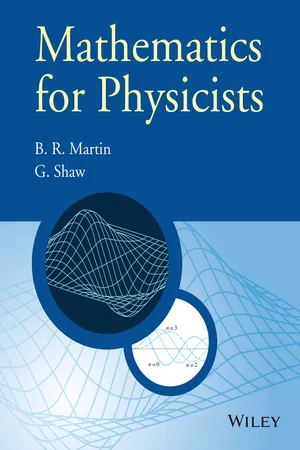Physics
Integral Calculus
Integral calculus is a branch of mathematics that deals with finding the accumulation of quantities, such as area, volume, and mass. In physics, it is used to calculate quantities like work, energy, and momentum by integrating functions that represent the rate of change of these quantities. It provides a powerful tool for analyzing continuous systems and processes in the physical world.
Written by Perlego with AI-assistance
Related key terms
3 Key excerpts on "Integral Calculus"
- eBook - ePub
- Fletcher Dunn, Ian Parberry(Authors)
- 2011(Publication Date)
- A K Peters/CRC Press(Publisher)
at that instant. The odometer, on the other hand, is a running tally, and the entire history since the car was first driven off the lot is included in its reading. Our girl under the sewing table must pay attention to the pedal the entire time if she is going to make an accurate estimate of the total amount of fabric consumed at any given time.Many types of engineering problems solved with integrals are couched in terms of continuous summations such as these: What is the total displacement, when I know the velocity function υ (t )? What is the total amount of water in the bathtub, given the history of the deflection angle of the faucet? How much fuel is remaining, given the burn rate as a function of time? To set up the integral for problems like these, we can first imagine approximating the value we wish to calculate by using a finite sum (∑) and a finite step size (Δx ). We then use a limit argument to replace the ∑ with a ∫, and the Δx with a dx (review Equation (11.22)). This is the essence of what is meant by a “continuous summation.”Of course, we can use the integral to calculate the area under a curve, as calculus textbooks are so fond of pointing out. As we sweep a line from left to right, the function being integrated determines the rate at which we are accumulating area. Where the function has a large value, our total area is adding up more rapidly, because the “slices” in that area are tall. However, from the viewpoint of a video game programmer, calculus textbooks seem to focus on this particular application of the integral in great disproportion to its application to real world problems.11.7.2 The Relationship between the Derivative and the Integral
Let’s see how we calculate integrals now that the purpose of an integral is (we hope) firmly grounded in your mind. Looking at the definition Equation (11.22), one wonders how in the world you can evaluate this limit. For the derivative, we were able to manipulate the expression being taken to the limit such that we could simply substitute Δt = 0, but this doesn’t seem possible in Equation (11.22). As it turns out, Equation (11.22) is mostly useful as a way to recognize when the problem you have is an integral, and is helpful to properly turn that problem into integral notation. It’s also used when we approximate integrals numerically, where instead of taking the slice width down to zero, we just stop at some small but finite Δx - eBook - ePub
- Morris Kline(Author)
- 2013(Publication Date)
- Dover Publications(Publisher)
CHAPTER 17THE Integral Calculus
More laws are vain where less will serve .ROBERT HOOKE17–1 DIFFERENTIAL AND Integral Calculus COMPARED
The material examined in the preceding Chapter belongs to the differential calculus. The basic process in this subject is to start with the formula relating two variables and to find the instantaneous rate of change of one variable with respect to the other. Suppose, however, that one began with the rate of change of one variable with respect to another and wished to find the formula which relates the two variables. For example, if we should happen to know that = 2x , could we find the relation between y and x ? One might expect that the answer is affirmative because it would seem that among the various functions whose derivatives we have obtained, there should surely be one whose derivative is 2x , and this function is the answer to our question. Except for a minor difficulty which we shall consider later, this expectation is correct. In this connection one might also ask whether there is any point in determining functions whose derivatives are given. The answer decidedly is yes. As we shall see, in numerous physical problems the most readily available information is an instantaneous rate of change, whereas the information sought can be best obtained from the function which relates the variables in question. Hence the process of finding the function from its derivative is immensely valuable—indeed, even more valuable than the basic process of finding derivatives from given formulas.The major idea characterizing the Integral Calculus is the inverse to that underlying the differential calculus: namely, instead of finding the derivative of a function from the function, one proceeds to find the function from the derivative. Of course, all really significant ideas prove to have extensions and applications far beyond what is immediately apparent, and we shall find this to be true of the Integral Calculus also. - eBook - ePub
- Brian R. Martin, Graham Shaw(Authors)
- 2015(Publication Date)
- Wiley(Publisher)
4 Integral Calculus We now turn from differentiation to the other crucial ingredient of the infinitesimal calculus, namely integration. This may be approached in two ways: either as the inverse process of differentiation; or as the means of calculating the area under a given curve, using an argument that serves as a template for many other important applications. However, before discussing these, we must develop the above two approaches, and the relations between them. 4.1 Indefinite integrals Given a function f (x), the indefinite integral F (x) is defined as the most general solution of the equation (4.1) It is not unique. Suppose we have a particular solution F 0 (x), with (4.2) Then the most general solution can be written (4.3) where G (x) is any function such that (4.1) is satisfied. On substituting (4.3) into (4.1) and using (4.2), one obtains, and so G (x) = c, where c is a constant. Hence the indefinite integral is given by (4.4) where F 0 (x) is any particular solution of (4.1) and c is an arbitrary constant. An alternative way of writing the indefinite integral is (4.5) for reasons that will become clearer in the next section. Thus (4.4) is often written in the form (4.6) The process of determining the indefinite integral of a given function f (x) is called integration, f (x) is called the integrand 1, and c the integration constant. In simple cases, it can be done using the standard table of derivatives, Table 3.1, together with the basic properties (4.7a) or, more generally, (4.7b) which follow directly from the definition (4.1), where a, b are arbitrary constants and f (x) and g (x) are arbitrary functions. For example, from Table 3.1 we have and so deduce that and hence, using (4.7a), where. For the case n = −1, we can use the result from Table 3.1, so that (4.8) In this way, one builds up the table of standard indefinite integrals shown in Table 4.1, from which other integrals may be deduced using (4.7)
Learn about this page
Index pages curate the most relevant extracts from our library of academic textbooks. They’ve been created using an in-house natural language model (NLM), each adding context and meaning to key research topics.


